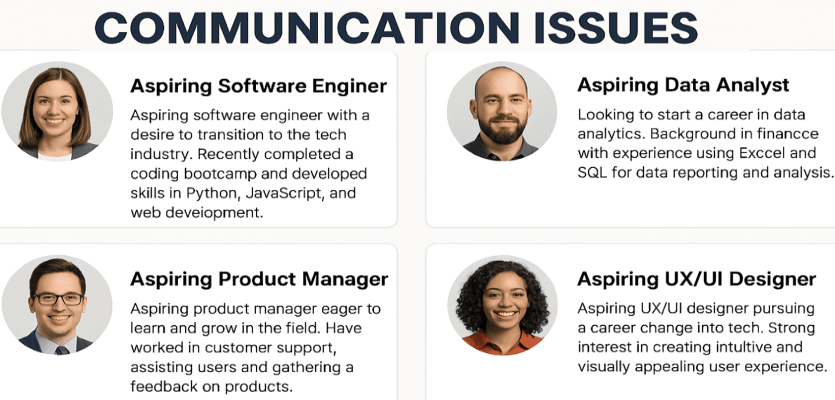A few days ago, I searched LinkedIn for people who describe themselves as “aspiring juniors.” What I found shocked me: 178,000+ results. 🤯 Many of them are students, yes — but a surprising number are already doing professional-level work.They also called themselves ‘aspiring’.💡 This made me reflect on something powerful: How often do we underestimate ourselves in the way we communicate? I’ve seen it again and again — people who are already capable, already delivering, but still waiting for permission to own their expertise. The title you give yourself matters. Positioning yourself as capable — even before someone gives you permission — can shift not only how others see you, but how you see yourself.
✅ You don’t need to wait for a job title to start showing up like a pro.
Let’s break this down into three mindset shifts that will empower your career transition into tech — especially in today’s turbulent market:
1. From “Aspiring” to “Experienced” — Reframe How You Show Up
Stop labeling yourself as “aspiring” if you’re already building, contributing, learning, and solving problems. Your communication on LinkedIn and your resume should reflect the experience and value you bring, not the doubts in your head.
🔄 Change your narrative:
- “Aspiring Junior Developer” → “Junior Developer building [X] with [Y tools]”
- “Career Switcher into UX” → “UX Designer focused on [specific interest or project]”
When you write your LinkedIn headline and summary, ask yourself:
Would I hire someone who describes themselves this way?
If not, it’s time for a rewrite.
Example of bad LinkedIn positioning:
1) Header : Aspiring Junior Data Analyst | Experienced in Research, Client Services, and Data-Driven Operations Across Multiple Industries
2) Experience:

Do you see the inconsistency? Either this person is ‘aspiring,’ or she is entering the new role as an employee who can learn quickly and contribute immediately after being hired. Employers don’t want to waste time teaching you all the basics! Stop communicating it like that!
2. Confidence Comes From Action — Not Just Thinking
It’s one thing to work on your mindset — it’s another to put it into motion.
Proactive actions like:
- Reaching out to decision-makers
- Networking with people in the roles you want
- Publishing thoughtful LinkedIn posts …are all ways to build not just confidence, but credibility.
🚀 When you act like someone who belongs in tech, people start to treat you that way. Don’t just visualize your future role — start operating from it.
3. Clarity Fuels Confidence (Not Just Motivation)
Knowing what you want to do — and why — gives you the kind of clarity that drowns out self-doubt.
If you’re still asking ChatGPT, “Who can I be in tech?”, that’s a start — but don’t stop there.
Go deeper. Reflect. Get help. With our candidates, we often use deep-dive consultancy sessions (shoutout to Klaudia 💼), and that’s where breakthroughs happen. When you’re crystal clear on your target role, the path forward becomes more actionable — and less scary.
🌱 Clarity leads to self-trust. Self-trust leads to consistency. Consistency builds a career.
👋 I’m Luke
I’ve made several career transitions — including into Tech — and today, I work 100% remotely from Poland for a U.S. company, earning in dollars. 💸
I’m hosting a FREE Masterclass on:
🗓️ May 7 at 11:30 PT 🎯 “How to Make a Career Pivot into Tech in Today’s Turbulent Job Market?”
💬 Drop a comment below to get the invite link ⤵️ This session is especially for career switchers who are ready to own their next chapter.
It’s time to stop calling yourself “aspiring” and start showing up like the pro you’re becoming. Let’s make this pivot together.
#CareerGrowth #CareerPivot #Junior #tips #linkedin


